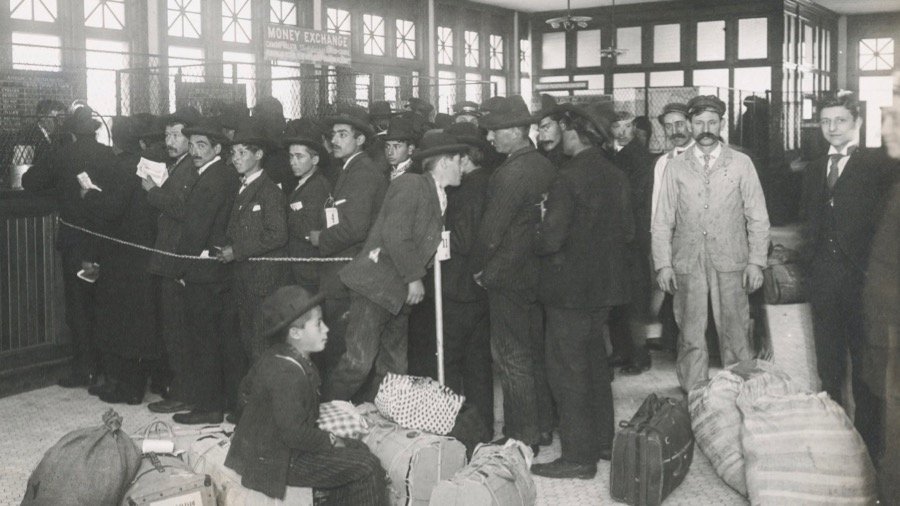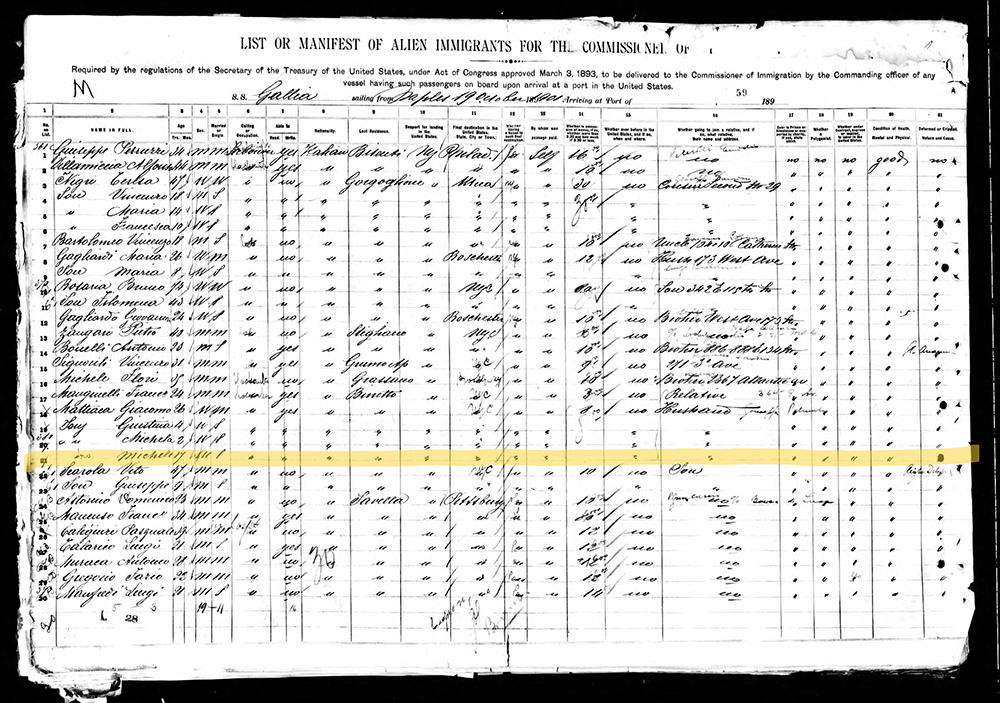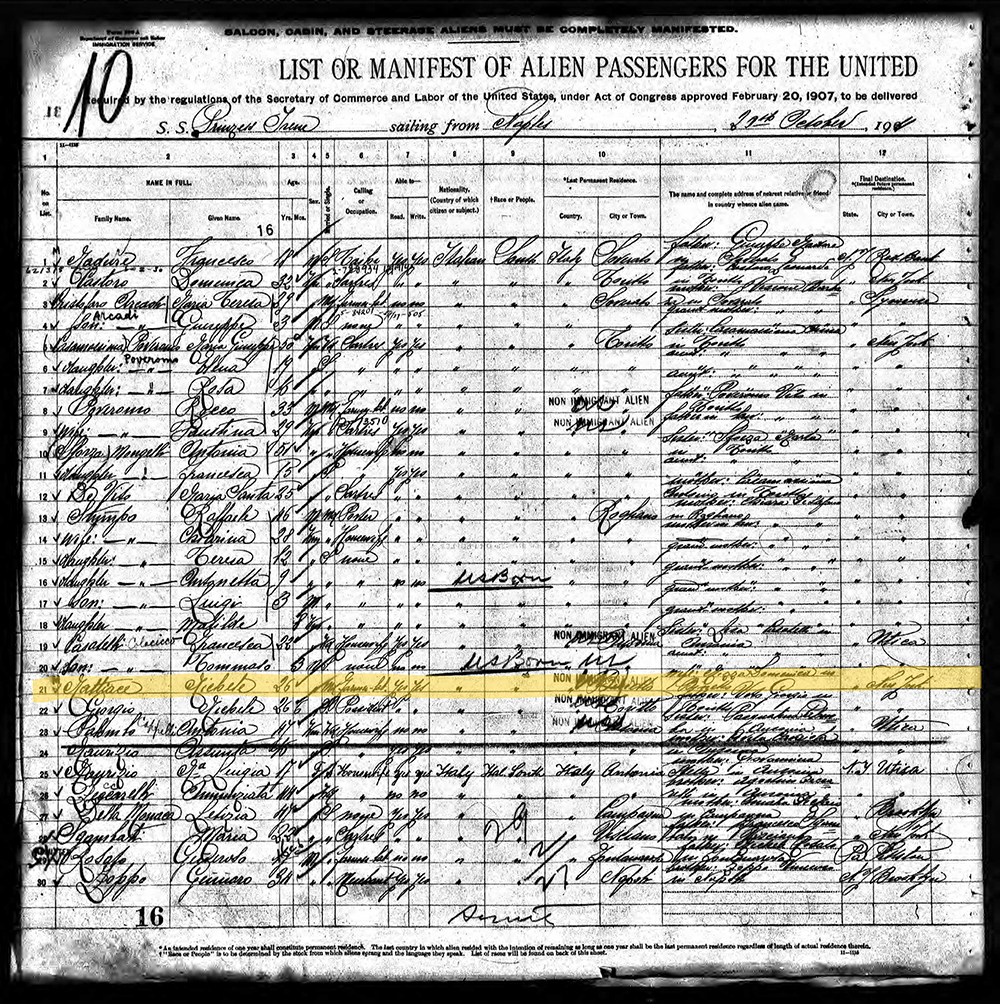The Great Arrival
From the 1880s to 1920s, the United States experienced a period of mass immigration with nearly 15 million immigrants arriving in only the first decade of the 20th century1. Of the over two million who came from Italy, in what is known as the Great Arrival, between 30 and 50 percent would return back home2. What many are unfamiliar with is how and why almost half of these travelers never planned to stay in the United States in the first place.
These immigrants who returned back to Italy have come to be known as birds of passage, traveling during a time when U.S. immigration regulations were looser. Due to lack of carefully recorded answers on passenger lists to a traveler’s intentions in America, you may find multiple records of first time immigration for your ancestor.

Birds of Passage - US World Herald3
Birds of passage, who were mostly young men, came to America with the goal of earning money to bring back home to their families with some of these men making as many as a dozen trips across the Atlantic. Historically from Italy, where they were known as ritornati or “the returned,” birds of passage had varying endings to their travels4. Some individuals dutifully made up to a dozen trips and settled back home, while others found great success in America and sent for their families to follow them and build a new life. Some others chose to start a different life altogether, deciding to not return to their wives or families back home and to stay in the United States.
While researching my second great-grandfather who immigrated to America, Michele Mattiace, I suspected he may have been a bird of passage. Originally hailing from a small southern town in Italy, he arrived at Ellis Island at the age of 17 in 1901, just as the immigration rate began to skyrocket. Whether his intention was to stay in the United States or not, Michele met his wife, my second great-grandmother, in New York City and together they built roots in the new country. And after finding five separate records of his travel between Italy and the States, Michele fit the characteristics of a bird of passage at the turn of the century.

Michele Mattiace’s first immigration to the United States in 19015
Why Italy?
Although every individual or family has their own unique story, there were several larger reasons why Italian birds of passage became so popular compared to immigrants from other nations. Like the rest of the globe in the early 20th century, Italians saw a boom of jobs in America due to expanding industrialization and understood the value of the American dollar which was still backed by the gold standard6. While in the previous decades, immigrants were mostly made up of merchants and those on solid financial footing, by the late 1800s, the United States began attracting more and more numbers of foreigners coming from poverty who were looking to create a better life for themselves and their family7.
Italy in the late 19th century had undergone a time of great social and political change, experiencing the unification of the Italian peninsula under a single rule. Although the Kingdom of Italy was established in 1861, the ramifications of this struggle for independence continued as industrialization hit the world8. While the north of Italy saw the effects of industry and were beginning to adapt, the south, which was based more around an agricultural society, found that much stayed the same. Although more notable in the south, local peasants around the entire kingdom still suffered tremendously under the toils of labor and exploitation. In the midst of dire poverty and political strife, the rumored American “streets paved with gold” was a worthwhile consideration and risk for Italian families9.
Unlike some other common European immigrants at the time from the Russian Empire, Ireland, or Austria-Hungary who were fleeing religious persecution, poverty, or political turmoil, many Italian immigrants were willing and able to return home. Many arrived in New York City and found the cramped, disease ridden, bustling metropolis second tier to the rolling hills of their homeland in Italy and were unwilling to suffer through the language barrier and the unfamiliar setting, preferring to only work in America. Despite the risks of entering the dangerous labor force of New York City, it is no wonder the idea of bringing American money back to Italy became so popular.
Immigration Passenger Lists
Originally U.S. immigration records were more focused on trying to manage the enormous volume of immigrants and getting people into the country, rather than recording who left. Only after 1917 were departing passenger lists required, yet these numbers were still not accurate as they did not dictate if the leave was permanent or just a visit home10. In fact, many records from these years also do not indicate whether the traveler made multiple trips or whether it was their first arrival or departure.
As years passed, when immigration and travel plateaued during World War I, records became more detailed. Into the 20th century, passenger lists started to be separated into returning immigrants and first arrivals. On some passenger lists, returning passengers received the stamp of ‘non-immigrant alien’ like Michele Mattiace did in 1911. The later the year, the more restrictive immigration and more precise the records became, and birds of passage began to lack the freedom that had previously allowed them to easily bring back their earned dollars home to Italy.

Michele Mattiace’s arrival to the United States in 1911, as a ‘non-immigrant alien’11
Effects on Genealogy and the Modern Day
Although it will take some digging and research to find documentation of the temporary stays of birds of passage in New York City, the travel records alone can help you piece together what your ancestor’s life may have looked like. Different arrivals have a good chance of coinciding with births, marriages, and deaths of relatives in the old country which your ancestor may have made a priority to attend. Passenger lists also may mention whether or not an immigrant was going to join a relative or relation who already made the trip to the United States.
Today over 17 million Americans claim Italian ancestry, most of whom can trace their immigrant ancestor to the generation of Italians during the Great Arrival12. The choice of many birds of passage to abandon their original plan to return back to Italy and have the courage to take a risk and stay in the United States, created a new life with new opportunities not only for themselves but also for countless of their descendants. While I will most likely never know the true story behind Michele Mattiace’s immigration to the United States and if he ever sent money back home, his choice to stay and build his family here paved the way to my existence today. The hints of his story from records over a century old, now understood with the context of the history of Italian birds of passage, brings much more meaning to his journey. Identifying your own ancestor who may have been a bird of passage can create connections and clues to contribute to understanding your family’s immigration story.
Footnotes
- “Immigrants in the Progressive Era : Progressive Era to New Era, 1900-1929 : U.S. History Primary Source Timeline : Classroom Materials at the Library of Congress : Library of Congress.” The Library of Congress, https://www.loc.gov/classroom-materials/united-states-history-primary-s….
- Simkin, John. “Italian Immigration.” Spartacus Educational, Spartacus Educational, https://spartacus-educational.com/USAEitaly.htm.
- Battaglia, Joe. “Birds of Passage.” Where Do Today's Italian Americans Come from?, 16 Apr. 2020, https://www.usworldherald.com/italian-immigration-to-america/.
- Calascio. “Immigration History.” Calascio.com, https://www.calascio.com/culture-and-history/immigration-history.
- Ancestry.com. New York, U.S., Arriving Passenger and Crew Lists (including Castle Garden and Ellis Island), 1820-1957 [Year: 1901; Arrival: New York, New York, USA; Microfilm Serial: T715, 1897-1957; Line: 21; Page Number: 59]
- “Birds of Passage | The Italian Americans.” THIRTEEN, 16 Apr. 2020, https://www.thirteen.org/programs/the-italian-americans/italian-america…. Accessed 3 Aug. 2022.
- “The Great Arrival : Italian : Immigration and Relocation in U.S. History : Classroom Materials at the Library of Congress : Library of Congress.” The Library of Congress, https://www.loc.gov/classroom-materials/immigration/italian/the-great-a….
- O'Rourke, Kevin H., and Jeffrey G. Williamson. “6 The Industrialization of Italy, 1861-1871.” The Spread of Modern Industry to the Periphery since 1871, Oxford University Press, Oxford, United Kingdom, 2017.
- “Streets Paved with Gold.” National Parks Service, U.S. Department of the Interior, https://www.nps.gov/elis/learn/education/streets-paved-with-gold.htm.
- “Registers of Vessels Departing from New York, New York, 8/11/1917 - 12/31/1971.” National Archives Catalog, https://catalog.archives.gov/id/3730419.
- Ancestry.com. New York, U.S., Arriving Passenger and Crew Lists (including Castle Garden and Ellis Island), 1820-1957 [Year: 1911; Arrival: New York, New York, USA; Microfilm Serial: T715, 1897-1957; Line: 21; Page Number: 32]
- “Italian American Statistics.” The National Italian American Foundation, 3 Mar. 2020, https://www.niaf.org/news/italian-american-statistics/.